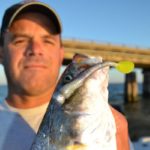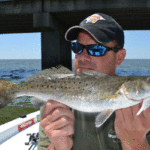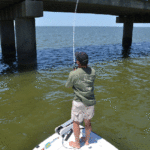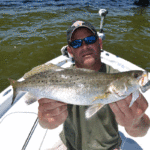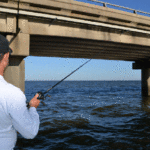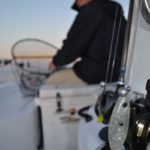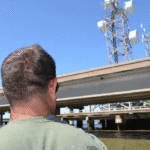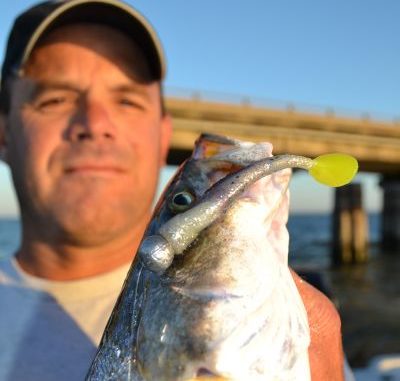
The Lake Pontchartrain Causeway can be a tough place to fish, but this bridge veteran feels it’s well worth learning.
The average horse’s heart weighs 7 pounds.
The historic racehorse Eclipse, a distant sire of triple-crown winner Secretariat, had a 14-pound heart.
That meant the horse, like his progeny from the 1970s, could go longer and faster than other horses. Beating in the cavity of his rib cage was a biological, genetic freak that gave him an unfair advantage over his competitors.
Capt. Sam Barbera is the Eclipse of Causeway fishing. The guy has the passion of a thousand anglers and an other-worldly stamina that makes him the King of the Causeway.
The bridge has defeated many a mere mortal. The Causeway is nothing if not monotonous. It’s 24 miles of synthetic sameness. Every stanchion looks just like the one next to it, and every row looks just like the next for miles into the horizon.
Its fish are notoriously fickle and finicky. You don’t have blue baits today? Ah well. Sorry. All they’ll bite is blue. Chartreuse is so yesterday.
And then there’s the noise. Fishing is supposed to be peaceful and relaxing, a day away from the world and its busyness and racket. But not at the Causeway. After 15 minutes there, you might be tempted to use your finest braided fishing line to tie a cinder block to your ankle and throw it overboard just to give your ears a break. The interminable thump-thump-thump of rolling tires and roar of truck exhaust makes Tiger Stadium on Saturday night sound like your local library.
And then there are the idiots who think it’s an original idea to honk and yell at fishermen.
Thousands of anglers over the years have heard the great reports from the world’s longest bridge — and tested their mettle there, only to snap their rods in two, buy a “For Sale” sign for the boat on the way home and take up golf.
It’s a chess match indeed. But it’s like a chess match against Kasparov.
Barbera, though, can’t get enough of the place. Literally.
On days when he fishes the Causeway — and there are many — he fishes from sunup to sundown.
Actually, that’s not entirely true. There are many days when even the sun’s melting into Manchac doesn’t give the guy a clue that it’s time to go home.
“The fishing’s great here after dark,” he says.
It’s also frequently great during the day, and Barbera is on a never-ending quest to crack the code as to what makes these fish bite.
He simply cannot get his fill of the Lake Pontchartrain Causeway.
“It’s unique, it’s challenging, its noisy,” he said during a late April foray into the land of broken fishermen. “It’s not the most relaxing place in the world to fish, but when you get that big thump and you know you’ve got a good fish, and it comes 12 feet up and starts dancing, it makes it worth it.”
And that truly is the irresistible lure of the Causeway. For whatever reason, the place holds big trout.
That doesn’t mean it’s devoid of frying-sized schoolies, but any hookset could legitimately be the biggest trout of your life.
Those days when he’s netted or hooked 7- and 8-pound trout haunt Barbera’s dreams. He knows the fish are there, and he knows they can be fooled. In his mind, he sees a big bruiser behind a piling, and he schemes of ways to fool that wily veteran.
In fact, on the day before this April trip, Barbera spent two hours “fishing” on the edge of a swimming pool so he could perfect what he calls a Pontchartrain rig — a 1/2-ounce bullet weight above a swivel tied to a 5- or 6-inch leader that, in turn, is tied to a Mustad live-bait hook.
On the hook, simply pierced through the nose, is a Yum Sweet Cheeks soft-plastic lure.
Barbera has a method for this particular madness. His theory is that Pontchartrain trout are used to feeding on pogies, which are neutrally buoyant. But when a trout inhales a jighead, the heavy lure feels like a cannonball in the fish’s mouth, so it instantly spits it out.
“It would be like a man biting into a car,” he said.
This is particularly true for older — and necessarily bigger — fish, those brutes that have thrived for many springs at the Causeway. They know what’s real and what isn’t.
That was apparent during Barbera’s April trip. He had multiple occasions when he felt a hard thump, set the hook and was rewarded with nothing but a straight rod.
He theorizes that, oftentimes, the hit-and-spit happens so quickly the angler doesn’t even know he’s gotten a bite.
So, by getting the weight off the lure, Barbera believes big fish will never know what they have in their mouths is anything but the real thing.
It also provides another benefit.
“When you get a hook in a fish, he immediately starts shaking his head back and forth,” Barbera said. “What’s this big 1/2-ounce (jighead) doing? It’s going back and forth, back and forth. He finally gets that right shake, and your bait’s out of his mouth.”
By having the weight off the lure, Barbera believes the fish will have less leverage to work with. It follows the same law of physics Coon Schouest did three decades ago when he developed the Coon Pop to catch massive and mad, head-shaking tarpon.
But for many Causeway anglers, worrying about what a fish does after it hits a lure is like contemplating how you’ll spend your winnings after simply buying a lottery ticket. It’s actually getting the fish to hit that’s the challenge.
And on the Causeway, every day’s pattern is just a little bit different.
“The general rule is you’re fishing the tide,” Barbera said. “The water’s moving around these pilings, and there’s an eddy right behind it. You’ve got to figure out where that eddy is, where that sweet spot is. Normally, that’s where your fish are going to be.
“The fish are being smart. They’re allowing the tide to bring them their food. Instead of them going to a buffet, the buffet’s coming to them.”
Where exactly the fish set up may not be the same every day because the currents aren’t the exact same.
“You can look at these pilings and draw a triangle behind each one,” Barbera said. “The fish are in that triangle.
Barbera, of course, doesn’t cast directly into the triangle, but his lure will certainly end up there.
“Cast the bait past the piling, let it fall, give it a couple hops,” he advised. “Sometimes you feel the bite, sometimes you don’t.”
That makes line-watching critical.
“If you see something a little goofy, feel something a little goofy, set the hook,” Barbera said. “It doesn’t cost you anything.”
Fruitless hooksets seldom result in lost tackle.
“At the Causeway, you don’t really have to worry about trash like you do at the bridges on the east side (of the lake),” Barbera said. “There’s not nearly as much rubble and rip-rap at the Causeway.”
What does result in lost tackle is Barbera’s endless quest during any particular trip to find the exact color and weight that the fish want each day.
Since his Pontchartrain Rig is still in the testing phase, Barbera’s bread-and-butter is the standard jighead and soft-plastic tandem. But while many Causeway regulars fish 3/8-ounce jigheads religiously, Barbera actually prefers 1/2-ounce heads.
“You’ve got to get the bait to the bottom,” he said. “That’s always the first piece of the puzzle.”
But figuring out the right color is the entertaining part of the puzzle, and Barbera switches rods and rips off tails more than a confused bass fisherman.
His favorite color, though, is the Slammin’ Sammy, a lure variation Capt. Dudley Vandenborre made after a request from Barbera. It’s got a junebug back with an off-white belly and chartreuse tail.
He feels the color looks most like the pogies lake trout feast upon.
“Matching the hatch is important no matter what the fish are feeding on,” Barbera said. “You want your bait to look like the ugly duckling of that particular species — something that’s not quite right, maybe having a bad day and lagging behind.”
Barbera sticks with his soft plastics even in the summer when many anglers convert to live bait. He admits that, in the blazing heat of late July and early August, the fish can be tougher to catch on artificials, but they’ll still bite them.
“The fish are 12 feet down where the water’s cooler,” he said, “and that’s where they normally are — right on the bottom.”
The best months to catch lunker trout on the Causeway are April, May and June, when the water is warming but not yet hot and the sows are all full of eggs. Barbera makes the bridge his go-to spot for all local rodeos and tournaments.
“It beats anywhere else in the world for me,” he said. “The great thing about the Causeway is every cast is hitting the reset button.
“You don’t know if your next cast is going to be a 14-inch schoolie or the next state record.”
With Barbera’s love of and commitment to the place, it may just be his hands holding that fish in the pictures.
To contact Capt. Sam Barbera, call 225-405-7827 or visit www.cptsam.com.
